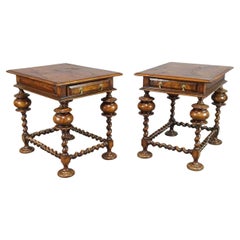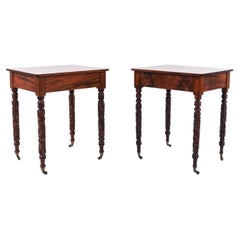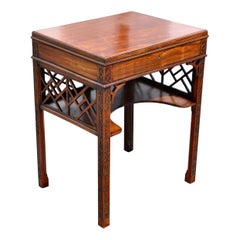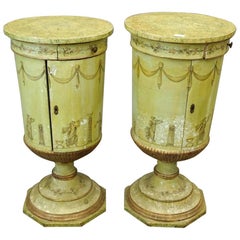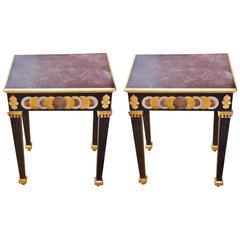Perim Lang Antiques End Tables
5
1
to
6
6
6
6
2
2
2
1
1
1
Height
to
Width
to
Depth
to
6
2
2
1
1
3
3
3
2
2
Pair of William and Mary Barley Twist Side End Tables
Located in Essex, MA
Pair of Custom English Oak Barley Twist End Tables in the Portuguese or William and Mary Style. Wonderful bulbous turned legs invoking an earlier form ...
Category
Early 2000s American William and Mary End Tables
Materials
Oak
Two American Mahogany Late Federal Style Side or End Tables
Located in Essex, MA
Two Late Federal Style Side Tables. Mahogany with beautiful New England carved and tapered legs. No drawers.
This similar pair were adapte...
Category
Antique Early 19th Century American Federal End Tables
Materials
Mahogany
18th Century Chinese Chippendale Side Dressing Table
Located in Essex, MA
George III 18th century English Chinese Chippendale mahogany side table. Fretwork and carved chinoiserie legs. Top opens to reveal a padouk interior fitted for dressing.
Truly a col...
Category
Antique Mid-18th Century English Chippendale Side Tables
Materials
Mahogany, Padouk
Pair of Venetian Paint Urn Form Bedside or End Cabinets
Located in Essex, MA
Pair of Venetian painted urn form cabinets. Neoclassical figures and festoons surrounding a charming urn shape. Storage cabinet and drawer.
Category
Antique Late 19th Century Italian Neoclassical Commodes and Chests of Dr...
Materials
Pine
Period English Robert Adam Painted Neoclassical Work Table, circa 1770
By Robert Adam
Located in Essex, MA
Period and original Adam style painted work or sewing table
-- Neoclassical
-- Hogarth type painting on top lid and a narrative work on the inside
-- Amazing condition of paint...
Category
Antique Mid-18th Century English Adam Style End Tables
Materials
Beech
Pair of Faux Porphyry Painted Side Tables
Located in Essex, MA
Wonderful pair of side tables
Designer created, artist painted
Neoclassical
Faux porphyry tops.
Category
Late 20th Century American Neoclassical End Tables
Materials
Maple
Related Items
19th Century Chinese Bronze Side Tables
Located in Los Angeles, CA
19th Century Chinese bronze end tables.
Category
Antique 19th Century Chinese Chinese Export End Tables
Materials
Bronze
Pair of Walnut and Tile Mosaic Side or End Tables
By Adrian Pearsall
Located in Rockaway, NJ
Pair of very nice vintage Mid-Century Modern mosaic tops walnut end tables.
Category
20th Century American Mid-Century Modern End Tables
Materials
Stone
Pair of French Directoire Chest of Drawers / Side Tables
Located in Westport, CT
A beautiful pair of Directoire chests in solid walnut and comprised of three drawers with brass angular handles and shield-shaped escutcheons,...
Category
Antique Early 19th Century French Directoire Commodes and Chests of Drawers
Materials
Walnut
19th Century Italian Renaissance Carved Barley Twist Walnut Inlaid Side Table
Located in Dallas, TX
Crafted in Italy, circa 1860, the elegant side table stands on barley twist legs connected with an elaborate X-stretcher at the base and embellished with central round finial. The antique table features a single drawer decorated with a carved lion head knob over a scalloped apron with intricate scroll and leaf motifs. The top with carved foliage around the edges, features an inlaid star medallion in the center. The occasional side table is in excellent condition commensurate with age and use, and adorns a rich walnut patina throughout; place this end table between two chairs in a man’s study or office...
Category
Antique Late 19th Century Italian Renaissance Side Tables
Materials
Walnut
H 31 in W 35.5 in D 23 in
Pair of Sorgue Side Tables
By Bourgeois Boheme Atelier
Located in Los Angeles, CA
Two side tables with cast bronze legs and marble tops.
Category
2010s American Organic Modern End Tables
Materials
Marble, Bronze
Swedish Pair of Painted Wood Gustavian Style Four-Drawer Side Chests
Located in Atlanta, GA
A Swedish pair of painted wood four-drawer side chests, designed in Gustavian style. This vintage pair of petite chests from Sweden each have a r...
Category
20th Century Swedish Gustavian Commodes and Chests of Drawers
Materials
Wood
Mahagony Flatware Chest End Table by Thomas Pacconi
Located in Plainview, NY
A beautiful Queen Ann style floor standing flatware or end table by Thomas Pacconi Classics ( 1900-2000). The elegant chest is finely hand-carved using ...
Category
Late 20th Century Queen Anne End Tables
Materials
Mahogany
19th C. French Charles X Restoration Period Sewing Stand Work Table
Located in Forney, TX
A scarce period Charles X (1818-1834) French Restoration mahogany travailleuse sewing (thread stand - side table - jewelry dressing table) with light, warm, beautifully aged patina.
Born in France in the early 19th century, almost certainly Parisian work, exquisitely hand-crafted, this exceptionally executed example features ornate gilt bronze ormolu mounts, escutcheons, and elaborate gilt metal trim. Having a highly figured light mahogany hinged lid top, lifting open to reveal a striking finished interior with divided compartments and original inset mirror plate. The conforming rectangular case fitted with a faux drawer front over a dovetailed drawer with sectioned interior. Elegantly rising on oval-shaped medial shelf stretcher-joined curvacious legs.
Dimensions (approx):
27" High, 20" Wide, 13.5" Deep
Stunning light almost blonde antique mahogany coloring and mellow warm tone, superb wood grain detail, and charming, beautifully aged patina over the whole. Great shape overall. Retaining original antique character marks, wear consistent with age and indicative of minimal use, nothing that detracts from the aesthetics or functionality, but only adds to the overall authenticity, refined elegant warmth, luxurious sophistication, and cozy unpretentious rustic elegance.
Delivered cleaned, hand waxed, polished French patina finish, ready for immediate use and generational enjoyment!
What is Charles X style:
The comte d’Artois – or Charles X - was the son of the dauphin Louis-Ferdinand de Franc and Marie-Josèphe de Saxe. He succeeded his two brothers Louis XVI and Louis XVIII and became the King of France in 1824. Thirty years after the French Revolution, he wanted to embody the return of monarchy and became the leader of the catholic party . As the previous kings, he was crowned in 1825 but he was soon overthrown by the revolution in July, 1830, called "Trois Glorieuses". He left then for England, Scotland, Prague and Istria where he died in 1836.
Charles X style lasted from 1818 to 1834 and happened during the Bourbon Restoration (French Restoration). This style did not replace totally the style of furniture from the French Empire but it was different from the formalism in the Napoleonic era, during which strictness and simplicity were inspired by Greco-Roman art. Indeed, artistic fields flourished. In terms of furniture, this renewal was suggested by the softening of shapes. Even though the simple aspect from the French Empire was still visible, shapes became curvier with volutes and arabesques. Another distinction is the loss of the massive aspect of furniture and the decrease of dimensions in order to decorate smaller appartments. Handling ability and comfort were key-words in the making of furniture. Apartments had essential elements such as chests of drawers, big rounded tables in the dining room, desks or secretaries, armoires and even dressing tables, comfortable fainting couches in the living room, small tables, pedestal tables, as well as gondola chairs. The wavy aspect of the latters certainly represent Charles X style the best.
One of the most emblematic features of this style is the use of bois clairs – light woods in warm blond tones - and indigenous woods that are varnished in order to highlight the grains. Bird's-eye maple, ash trees, plane trees, yew trees, beech trees, olive trees and cedar trees were most likely to be used. Indeed, at the beginning of the 19th century dark woods were hard to find. In 1806, the Napoleon’s Continental System was established in order to ruin the United Kingdom by preventing the country from any business with the rest of Europe. Therefore craftsmen had to find alternatives from mahogany which was the most commonly used material at this time. After 1815, the import of wood was even more difficult because of peace treaties and the European political situation, which contributed to the popularity of the bois clairs and indigenous woods. The furniture was often decorated with fine inlays made out of dark wood representing foliage, which contrasted with the veneer. Even though these patterns can look like bronze decorations from the Empire era, they were far more simple and did not represent any military or mythological attributes. On the tables, trays were sometimes made out of marble as in the French Empire, but it was often put aside and inlaid veneer, Verre Eglomisé – a type of glass with a mirror finish –, mirror or porcelain from Sèvres or Paris were more likely to be used.
Decorative elements from the Monarchy were highly appreciated again as they suggested luxury. Indeed, marquetry work was particularly fashionable - Boulle marquetry thrived around 1820 as the works of the Levasseur family can show. In the same way, draperies and trimmings referred to the monarchist splendour. Fabrics were often white – the traditional colour of the Bourbons – or light coloured as oppposed to the typical green from the Napoleonic era.
One of the most symbolic figures from this period of time might be Jean-Jacques Werner (1791-1849), a cabinetmaker who worked for prestigious clients such as the Duchesse de Berry who was Charles’s step-daughter. His works can be seen at the Musée des Arts Décoratifs and at the Grand Trianon in the Palace of Versailles. The duchess’s appartments situated at the pavillon de Marsan and at the Palais de Saint Cloud illustrate Charles X style the best with furniture made out of bois clairs and ornamented with dark wood patterns or fine gold decorations.
Chales X style allows a transition between the sobriety of the Empire style and the abundant aspect of Louis-Philippe style. The gothic style started at this time through the "style à la cathédrale", inspired by religious architecture, which thrived from 1827 to 1830. Indeed, at the beginning of the 19th century, Romanticism put the spotlight on the Middle Ages. Cabinetmakers were not inspired by the medieval furniture but rather by architectural elements of churches and cathedrals. For instance the backs of chairs were decorated with arches shaped like rib and serration. In the same way, before Charles X abdicated, pieces of furniture were made out of dark woods – such as mahogany, which was used again in France – and were inlaid with light wood. Romanticism also influenced the layout of furniture in appartments to suggest movement through a mix of various styles, various shapes and various sizes, as opposed to the static aspect of Neoclassicism. The start of industrialisation and mechanisation also influenced this style as early technical developments led to the production of pieces of furniture in series.
Credit:
Marc Maison
Bibliography:
FANIEL Stéphane (Dir.), Le Dix-neuvième Siècle Français, Collection Connaissance des Arts, 1957, Hachette
SASSONE, Adriana Boidi, Furniture from Rococo to Art Deco, 2000, Evergreen
--
Extremely versatile:
As warm and attractive as it is useful, this remarkable antique table having the ideal size and small proportions for a variety of different uses, including as a side table, accent or occasional table, tall sofa...
Category
Antique Early 19th Century French Charles X End Tables
Materials
Bronze, Ormolu
English Occasional Table, circa 1900
Located in High Point, NC
English oak occasional table with a beveled edge around the top over a simple apron and supported on hand turned barley twist legs, joined by simple cross stretchers and raised on ha...
Category
Antique Early 1900s English Edwardian Side Tables
Materials
Oak
Louis XVI Two Tier Cherrywood Side Table French 18th Century
Located in San Francisco, CA
Louis XVI Country French two tier side table with cutouts, single drawer standing on cabriole legs. Circa 1780
Cherrywood side table with beautiful original finish. France, 18th ce...
Category
Antique 18th Century French Louis XVI End Tables
Materials
Cherry
Pair of Vintage Italian Carved Walnut Bedside Chest of Drawers
Located in Forney, TX
A handsome pair of Italian bedside chests, born in the mid 20th century, in a distressed rustic finish, fitted with one open shelf, over two dra...
Category
Mid-20th Century Italian Commodes and Chests of Drawers
Materials
Wood
Stacked End Tables in Black Ceruse
By Stamford Modern
Located in Westport, CT
Inspired by the iconic designer Paul Frankl, these rustic modern end tables blend timeless elegance with contemporary flair. The oversized drawer frames and subtly curved fronts crea...
Category
21st Century and Contemporary American Mid-Century Modern Commodes and C...
Materials
Brass
